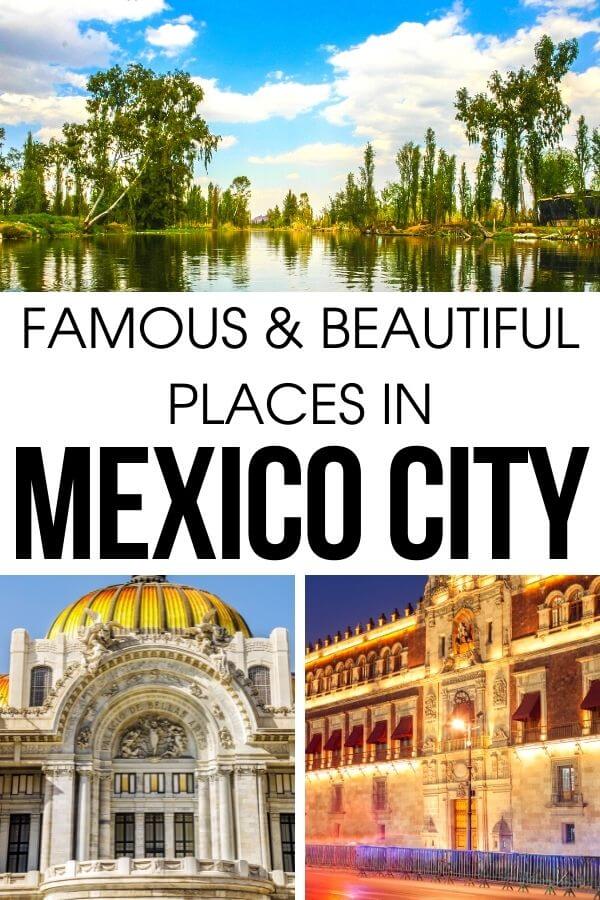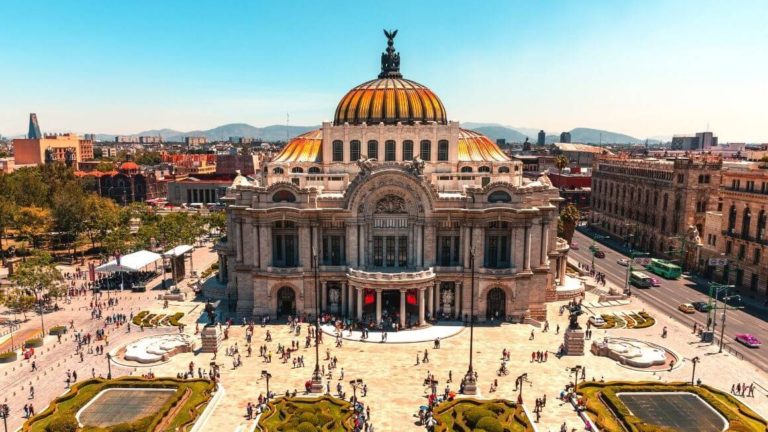Last Updated on January 23, 2024 by Soumya
Looking for the famous landmarks in Mexico City to add to your travel itinerary? You’re at the right place.
Because of its storied history and interesting landscape, Mexico City has many historical sites and natural attractions.
From the ancient pyramids of Teotihuacan to modern skyscrapers like Torre Latinoamericana, the list of famous buildings in Mexico City is endless.
In this article, we bring to you 15 most iconic Mexico City landmarks that totally deserve a visit.
Good news is that many of these famous places lie in the Mexico City Historic Center which means you don’t need to venture far to see them all.
Please note: This post may contain affiliate links which means I may earn a commission if you make a purchase by clicking a link on this post. This will be at no additional cost to you. Affiliate links help me keep this website up and running. Thanks for your support!
Top 5 Famous Mexico City Landmarks
Blue House or Frida Kahlo Museum
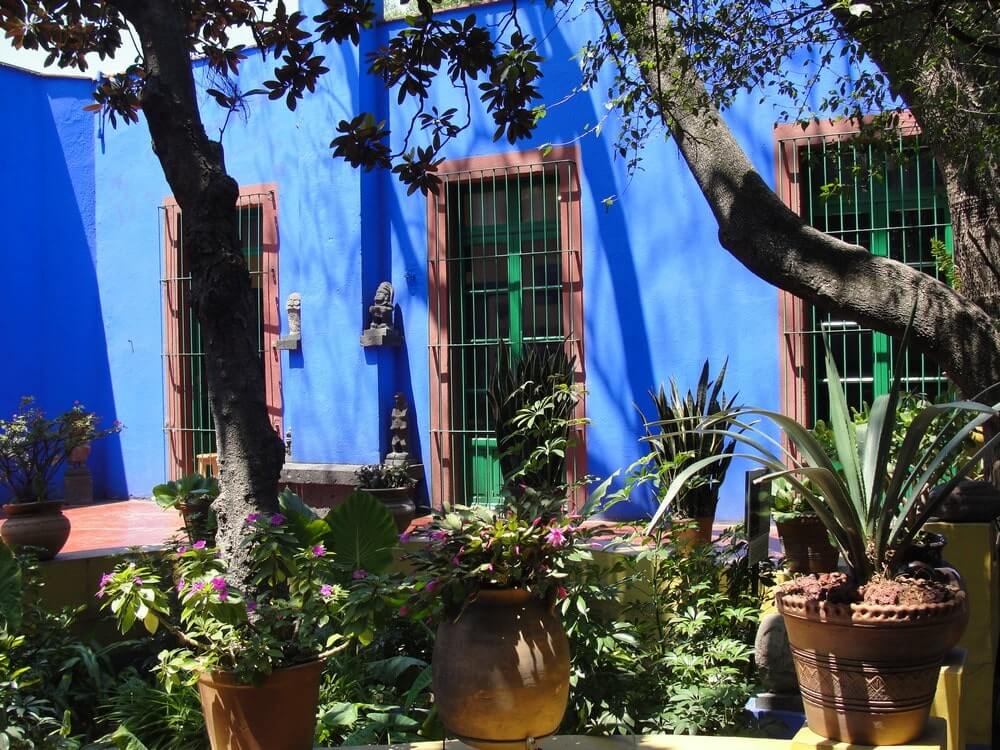
Image courtesy: Carole from Travels with Carole
Don’t leave Mexico City without visiting Casa Azul, or the Blue House or Frida Kahlo’s Museum, one of the most iconic Mexico City landmarks.
Located in the Coyoacan neighborhood of Mexico City, the Blue House is where Frida took birth, grew up, lived, and died.
The Blue House is a historic home and art museum where you can see snippets of Frida Kahlo’s personal life, her art, and an interesting collection of her dresses. You can have a virtual look at the collection here on Google Arts & Culture.
Check their official website for guided tours and opening hours when planning your trip to the museum.
Thronged by ardent Frida Kahlo fans throughout the year, the Blue House is one of the most visited historical sites in Mexico City.
✦ Pro Tip: Tickets to the Blue House tend to sell out really fast. Be sure to book your Frida Kahlo Museum tickets well ahead of time.
Mexico City Metropolitan Cathedral
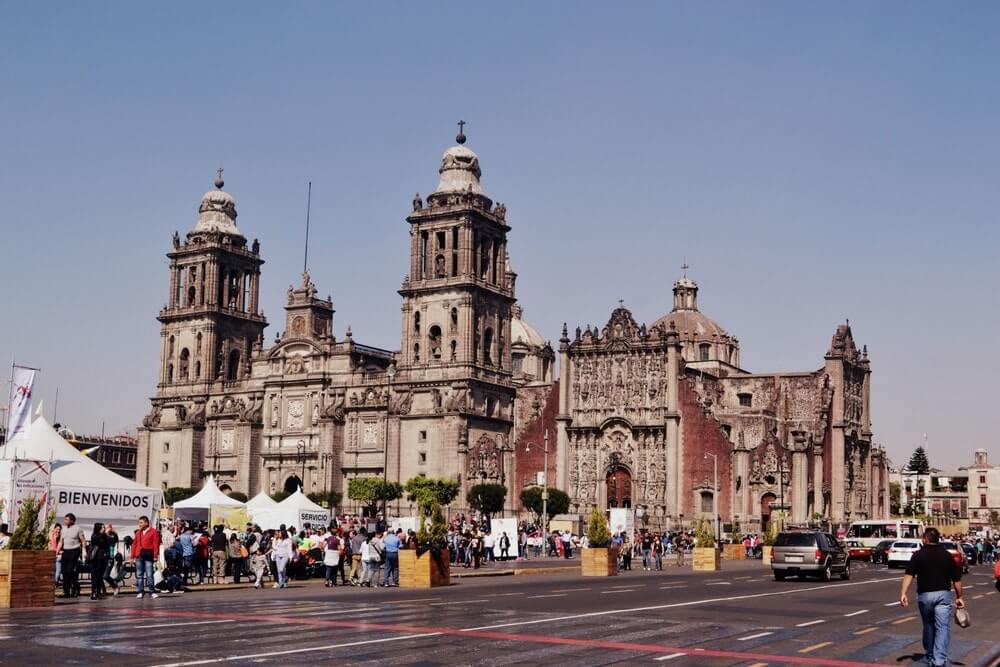
The Metropolitan Cathedral is yet another stunning Mexico City landmark that you need to have in your travel itinerary.
Located on El Zocalo, the Metropolitan Cathedral or Catedral Metropolitana is one of the largest and most impressive cathedrals in Latin America.
The cathedral has an interesting past as well as a concerning present.
Spanish conquistadors built the Metropolitan Cathedral on the ruins of main Aztec temple after they defeated Aztecs in the 16th century.
Bricks and stones from the old Aztec temple were used to construct the cathedral.
What is interesting about the present of Metropolitan Cathedral is that every year, the cathedral along with every other building in Mexico City Center sinks a few inches into the ground.
The phenomenon is called subsidence and eventually, Mexico City could sink up to 65 feet!!
✦ Pro Tip: Want to find more such interesting things about Mexico City? Check out this article on 21 Mexico City Facts No One Told You.
Pyramids of Teotihuacan
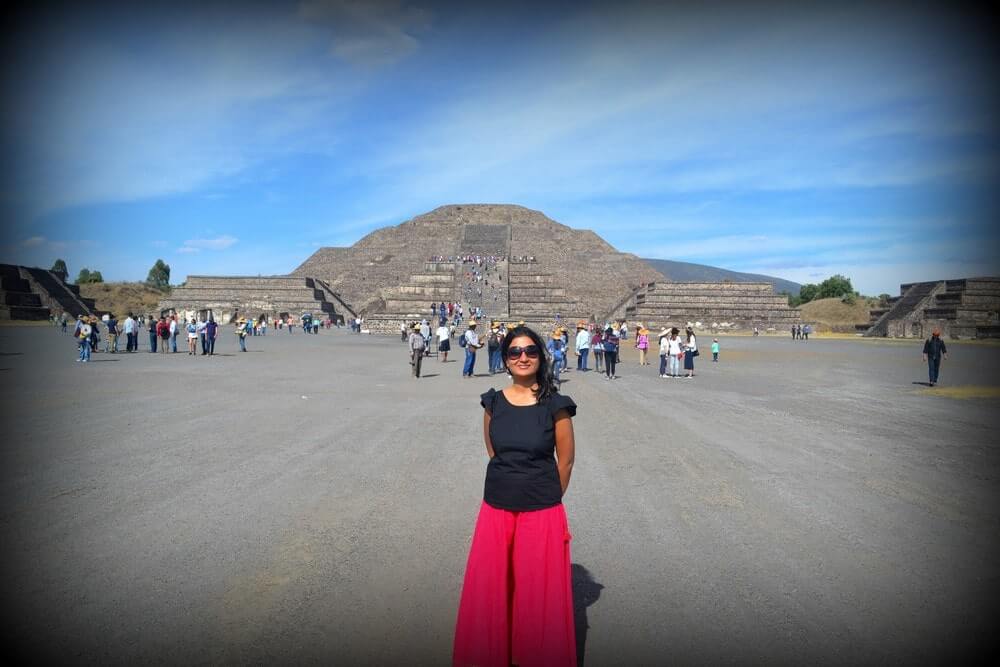
The gigantic pyramids of Teotihuacan are the important historic landmarks of Mexico City and an exciting thing to see in Mexico.
Located only 30 miles northeast of CDMX, Teotihuacan makes for a wonderful day trip from Mexico City.
There are many wonderful things to see in Teotihuacan including the enormous Pyramid of the Sun, the mystical Pyramid of the Moon (animal and human sacrifices were a ritual here), and the smaller Pyramid of the Feathered Serpent which features the popular Mesoamerican deity, Quetzalcoatl.
If you are an art enthusiast, you will love checking out Teotihuacan’s extensive mural collection. They are colorful and depict life and beliefs from 2000 years ago.
Unlike other ancient Mexican cities of which we have some accounts, Teotihuacan is full of unsolved mysteries.
There are so many things about Teotihuacan that still baffle researchers.
For instance, who built this massive city, what kind of people lived here, what language did they speak, and where did they disappear at the end of 8th century.
Teotihuacan is one big enigma waiting to be unraveled to the world.
📖 Related Read: If you would love to find out more, check out our article on the 14 puzzling facts about Teotihuacan.
Palacio de Bellas Artes
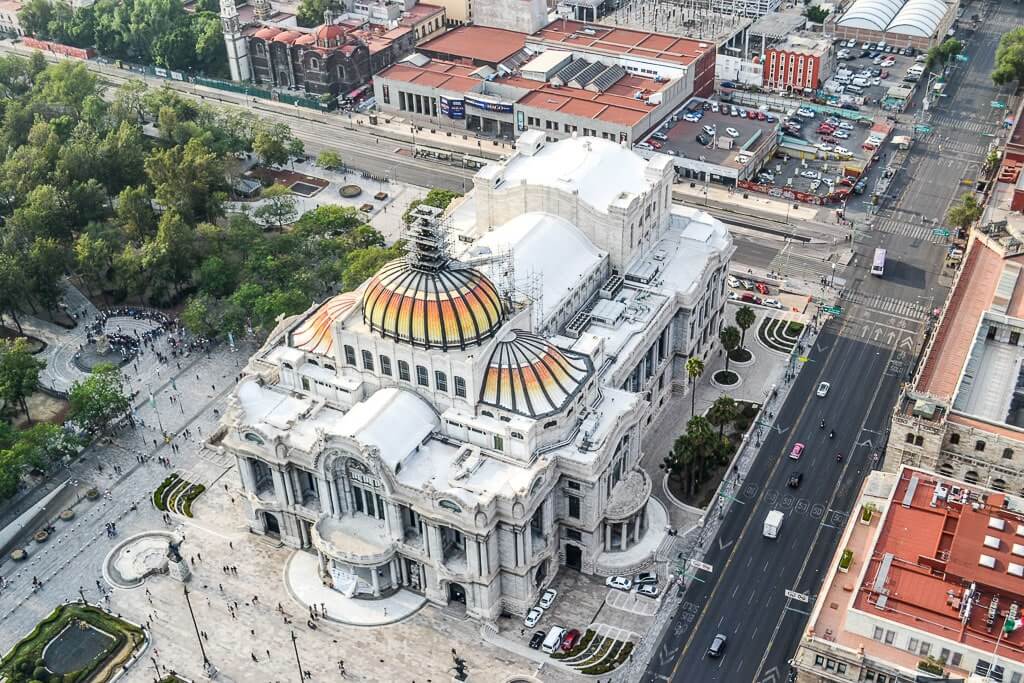
Built between 1904 – 1934, Palacio de Bellas Artes or the Palace of Fine Arts is one of the latest and prettiest additions to Mexico City’s center.
Like the name suggests, the building was built to encourage and promote fine arts in the country.
Therefore, you will find a large theater, concert hall, museums, and several art galleries (including those of the masters Frida Kahlo and Diego Rivera) here.
You can also watch a Mexican Folklore Ballet, filled with colorful costumes and vibrant narratives at the Fine Arts Palace.
The Palace of Fine Arts itself is an architectural masterpiece.
The façade is a complex mix of Art Nouveau and Renaissance styles, richly crafted interiors, and domes painted in orange and yellow make Palacio de Bellas Artes an absolute beauty.
National Anthropology Museum
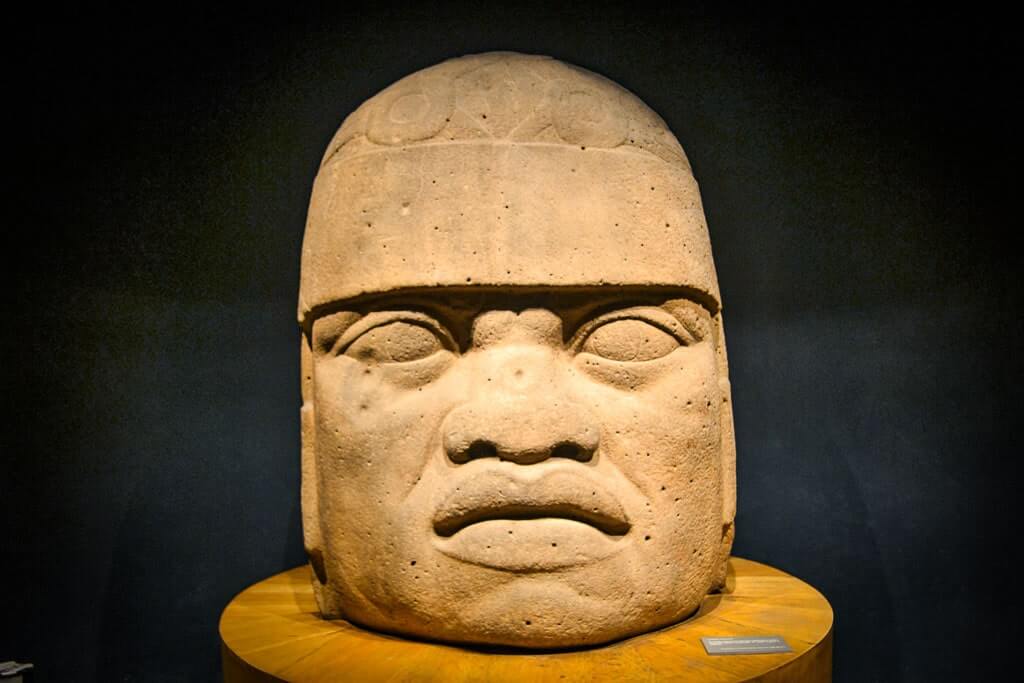
The National Museum of Anthropology in Mexico City is one of the best museums I have visited anywhere in the world.
It is vast and entirely dedicated to the pre-Hispanic era of Mexico’s history.
If you’re keen to dig deeper into the archaeology, art, and ethnicity of Mexico’s indigenous civilizations, then you have to visit this famous Mexico City landmark.
The museum is located within the Chapultepec Park in Mexico City and has 23 permanent exhibit halls.
There are rooms dedicated to several Mesoamerican civilizations such as the Teotihuacanos, the Mayans, the Olmecs, and the Aztecs.
Highlights of the museum include the Sun Stone or the Aztec Calendar Stone, replica of Pakal’s tomb from Palenque, and Olmec giant stone heads.
If you are planning to visit Teotihuacan, be sure to check out the Teotihuacan murals at the museum.
Also, if you are planning a trip to any of the Mayan pyramids in Yucatan (including the mighty Chichen Itza), do not forget to see the Mayan displays.
✦ Pro Tip: Mexico City Anthropology Museum is huge. I recommend visiting with a knowledgeable tour guide for a memorable experience.
Historic Landmarks in Mexico City
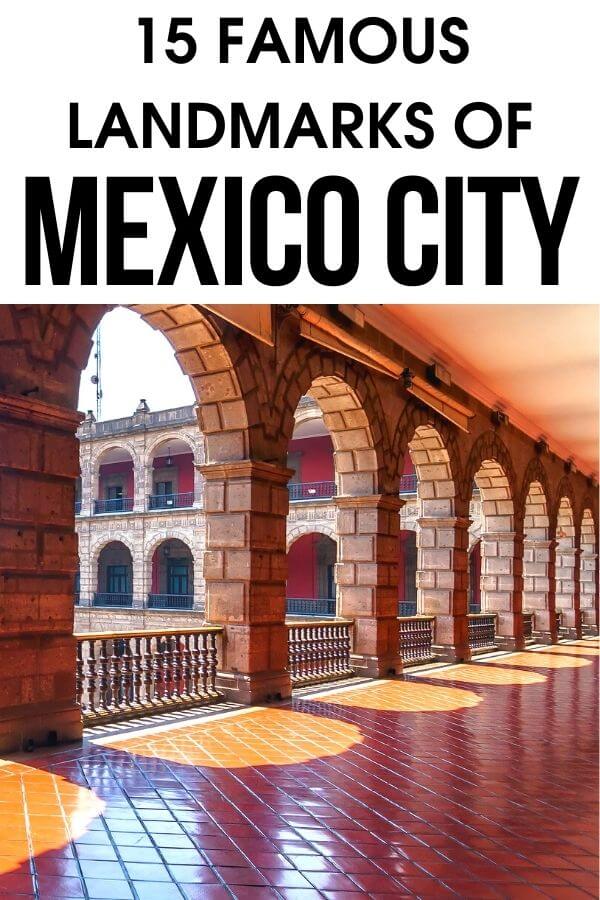
El Zocalo
El Zocalo is Mexico City’s central square.
Also known as Plaza de la Constitucion, the Zocalo is one of the most famous landmarks in Mexico City and an absolutely unmissable one.
The plaza has been around since the time of the Aztecs.
The Zocalo’s importance is quite evident by the number of Mexico City iconic buildings that surround it. Metropolitan Cathedral, Templo Mayor, and National Palace are all next door.
Even today, Zocalo is the most important public square in Mexico City.
It is the venue for military parades, religious festivals, concerts, and public protests. The famous Day of the Dead festivities also happen here.
You will find the best street food here along with numerous shopping and people-watching opportunities.
If I were to describe the Zocalo in just one phrase, it would be the “Heart of Mexico City”.
📖 Related Read: Downtown Mexico City is built around the Zocalo. Read about the 20 best things to do in Mexico City Downtown.
The Angel of Independence
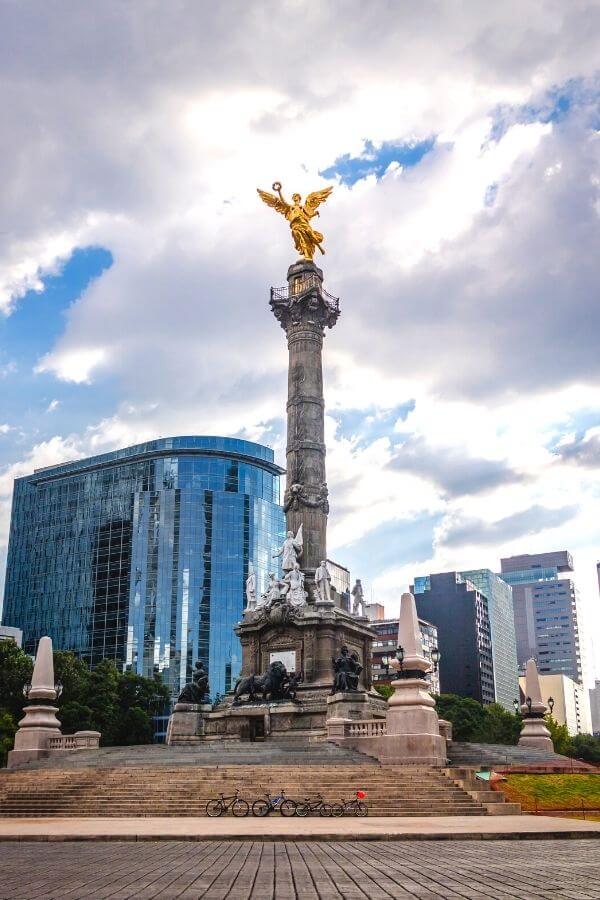
One of the most famous monuments in Mexico City is El Angel or The Angel of Independence.
Located on Av. Paseo de la Reforma in the Juarez neighborhood, this famous Mexico City monument commemorates Mexico’s victory over Spain in its War of Independence.
It is ironic that the Angel was built in 1910, almost 100 years after the Independence War but around the same time as dissent was brewing against Porifio Diaz, Mexico’s infamous dictator president.
It was Diaz who actually oversaw the completion of the monument but was overthrown soon after in May 1911.
Today, El Angel is one of Mexico’s iconic attractions and an unforgettable symbol of Mexico City.
Not only is this the favorite place for selfies but also a common venue for political meetings and protests.
Ruins of Templo Mayor
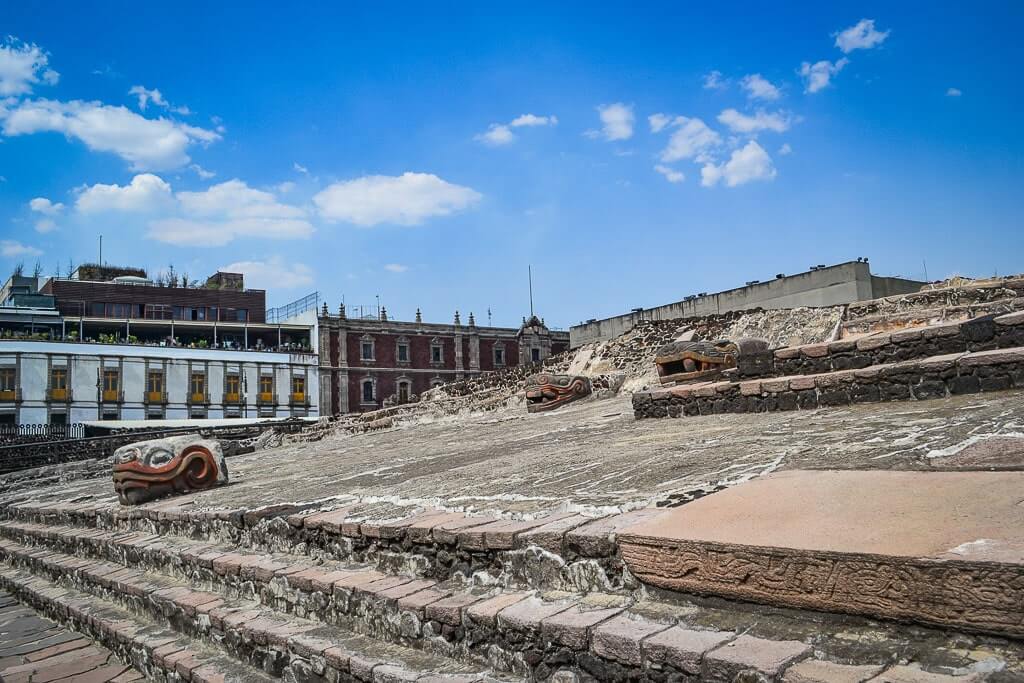
Looking for the ancient Aztec city of Tenochtitlan? It is no longer there because it was razed to the ground by Spanish conquistadors.
But you can still visit the museum and ruins of Templo Mayor at the Zocalo.
Templo Mayor was the primary religious center of Aztecs.
There was a massive pyramid temple here that had not one but two shrines on top. They were dedicated to the Aztec God of Rain (Tlaloc) and the God of War (Huitzilopochtli).
Today, you can visit the ruins of Templo Mayor and see remnants of old walls, serpent heads, ancient staircases, and the area where the main temple once stood.
Be sure to drop by the Templo Mayor Museum which is a treasure house of Aztec historical facts. There are separate rooms for Aztec deities, rituals, trade and commerce, plants, and animals.
📖 Related Read: Find out more about Aztecs in our guide on the Best Aztec Ruins in Mexico City.
Mexico City National Palace
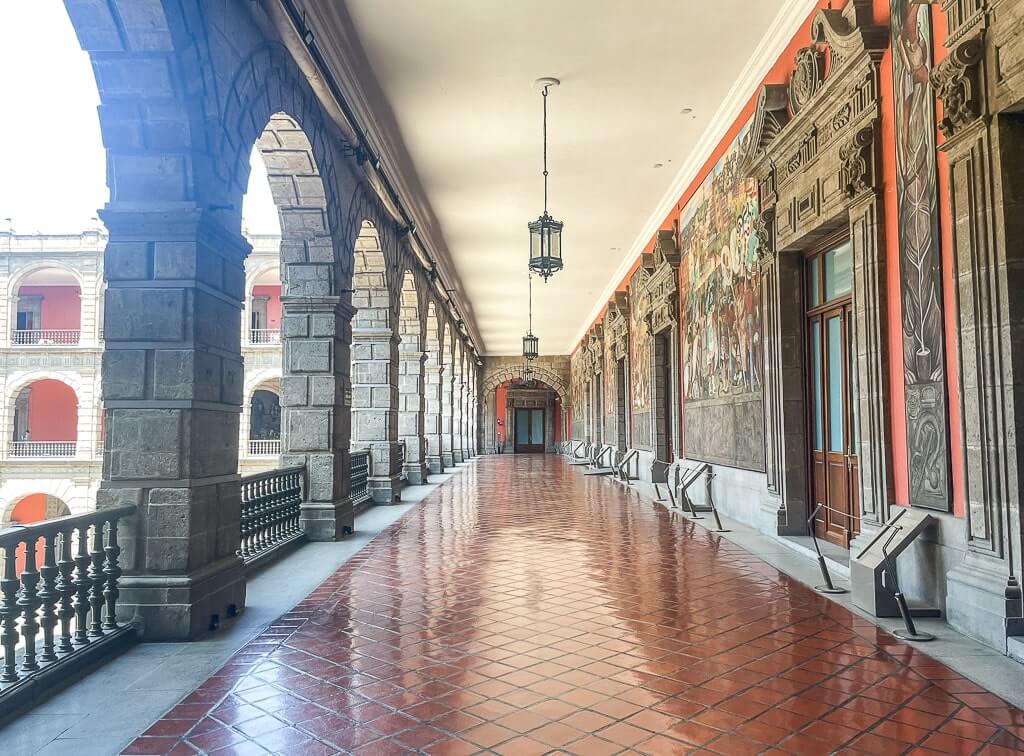
Palacio National or the Mexico City National Palace is a massive colonial building located to the east of the Zocalo.
It is an active government facility and is home to the treasury and offices of the Mexican President.
It is interesting to note that the National Palace was built on the ruins of the palace of the Aztec Emperor, Moctezuma II.
Today, it is a huge building with several grand rooms, a chapel, numerous courtyards filled with fountains, and a big library.
However, what is totally unmissable about the palace is its unique collection of Diego Rivera’s murals.
Do not forget to catch a glimpse of Rivera’s most famous creation, “The History of Mexico”, that is housed in the palace’s stairwell.
✦ Pro Tip: Read our National Palace Visitor’s Guide to see the best that this historical palace has to offer.
Chapultepec Castle
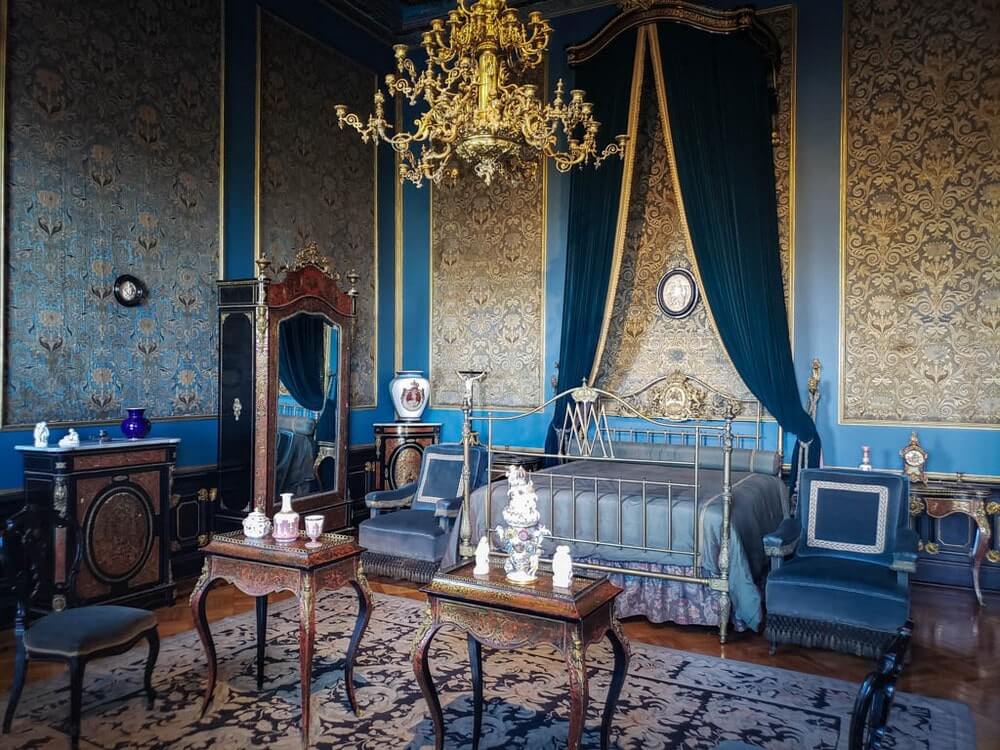
Even though it is hard to find castles in North America, there is one right here in Mexico City.
The beautiful Chapultepec Castle with stunning interiors is the only place to have housed royals in North America.
As with every other castle in the world including Neuschwanstein in Germany and Pena Palace in Portugal, Chapultepec has a long and notorious history.
It was built in the late 18th century, abandoned during the Mexican War of Independence, and became the site of the deaths of 6 young men during the Mexican war with America.
Later, it became the home of Maxmilian I of Second Mexican Empire which fell from power in 1867.
Today, Chapultepec Castle is one of the most famous historical sites in Mexico City.
Some of the most iconic rooms here are Maximilian’s bedroom, the dining room, and the Malachite Room. The palace’s stained glass windows are especially remarkable.
Be sure to visit the statue dedicated to the Young Heroes or the Ninos Heroes who gave their lives defending the castle during the Mexican-American War.
The castle is located on top of Chapultepec Hill in the middle of green and verdant Chapultepec Park.
✦ Pro Tip: Visit Chapultepec Castle on this guided tour to learn more about its history.
Famous Natural Landmarks in Mexico City
Floating Gardens of Xochimilco
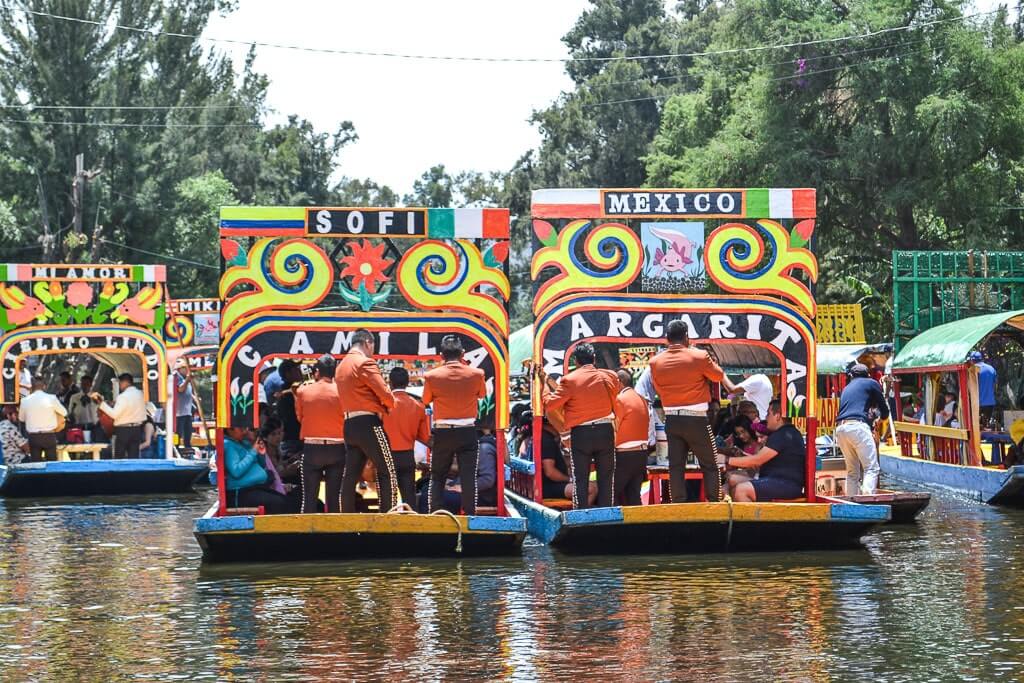
Often touted as the Venice of Mexico, Xochimilco is a popular day trip destination from Mexico City.
Xochimilco is filled with canals and floating gardens known as chinampas.
The chinampas are sort of artificial islands that locals built a long time ago with soil, branches, and reeds.
Even today, these islands form an important gardening and agricultural hub. And of course, they are one of the most popular natural landmarks in Mexico City.
Hundreds of tourists and locals visit Xochimilco every day.
They cruise through the canals in colorful trajinera boats while enjoying live Mariachi music and savoring fresh Mexican food.
Xochimilco’s canal and chinampa system, also a UNESCO World Heritage Site in Mexico, is always a hub of activity.
It is not the place to go to if you are looking for peace and calm. But it is the best place to people watch and soak up on local Mexican culture.
✦ Pro Tip: Find out how to visit Xochimilco’s Floating Gardens from Mexico City.
Mexico City Chapultepec Park
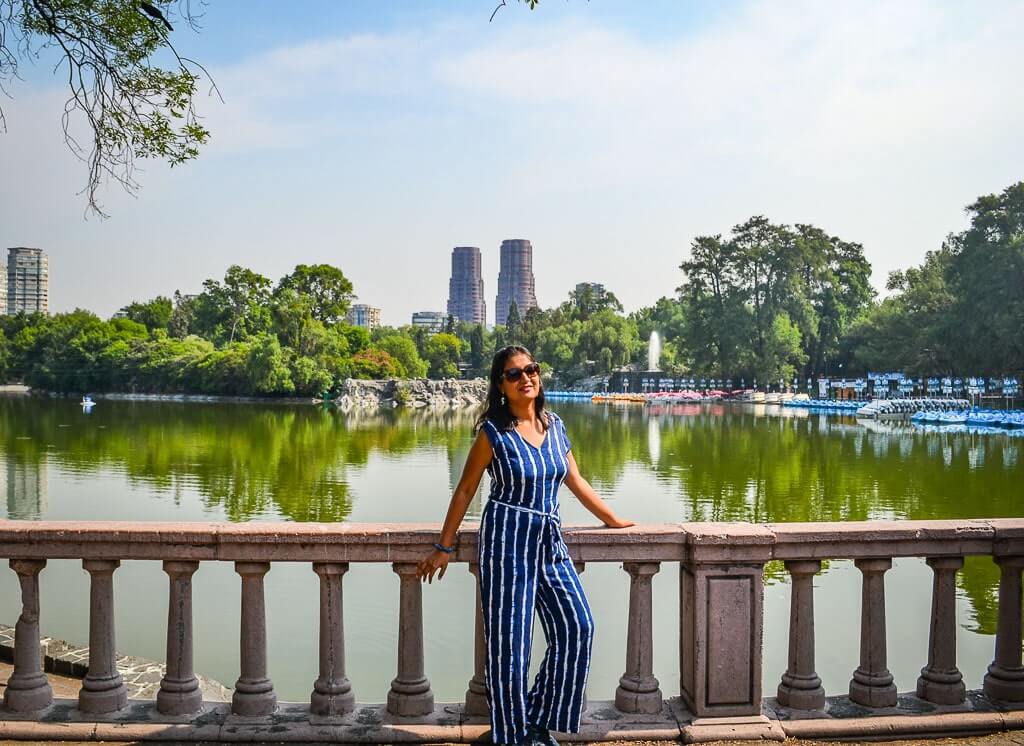
Chapultepec Park or Boqsque de Chapultepec is a huge city park located to the southwest of Mexico City Center.
Spread over nearly 700 hectares, it is one of the largest parks in the Americas and one of Mexico City’s much-needed green spaces.
Come here if you are looking for some peaceful time with yourself.
Or come here for the scores of leisure and cultural attractions that the park offers.
The park is home to Chapultepec Castle, Museum of Anthropology, Chapultepec Zoo, El Papalote Children’s Museum, Museum of Modern Art, Tamayo Museum, and so much more.
Bring along a picnic or choose some snacks from vendors who sell anything from fresh fruits to fried empanadas because you are definitely going to need more than a few hours here.
Alameda Central Park
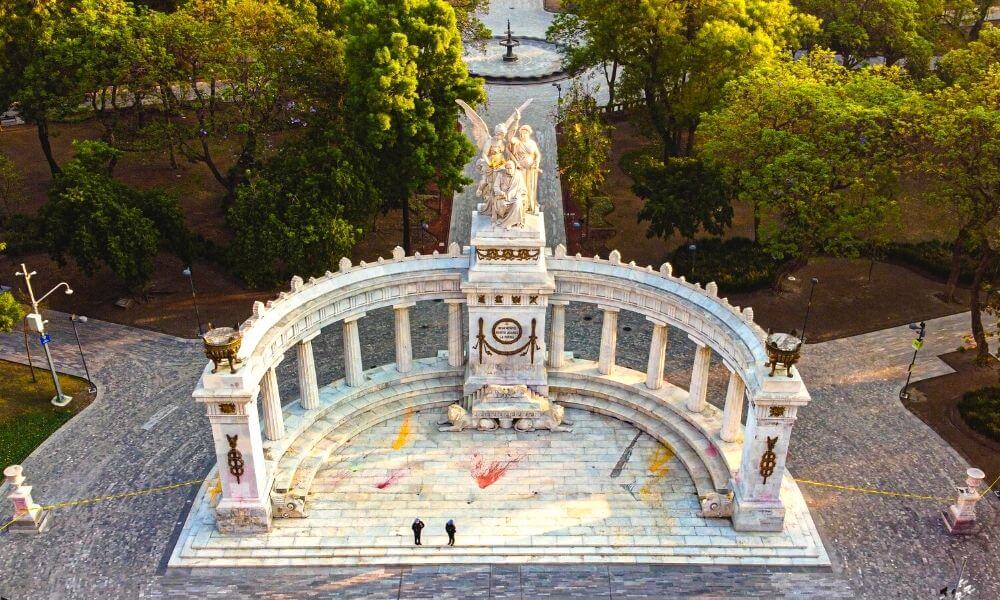
Image courtesy: Canva Pro
Alameda Central is yet another green lung of Mexico City that has been in existence since the time of the Aztecs.
In fact, this used to be a large, central marketplace for the Aztecs.
When the Spanish came in the 1500s, they converted it to a public park.
The Central Park of Alameda is full of gardens and pretty walkways lined with statues and water fountains.
There are so many statues and sculptures here that you will feel like walking through an art and history museum.
Some of the most iconic ones are the Benito Juarez Hemicycle (pictured above), the Beethoven Monument, and the fountains of Venus, Neptune, Las Danaides, and La Primavera.
Other Famous Landmarks of Mexico City
Basilica of Our Lady of Guadalupe
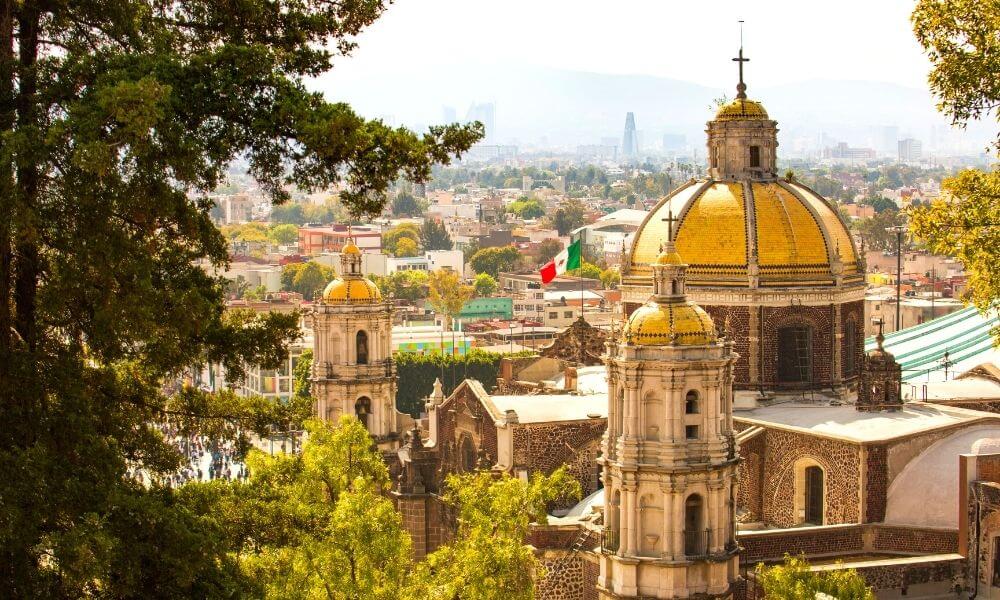
Image courtesy: Canva Pro
One of Mexico City’s most important religious landmarks, the Basilica of Our Lady of Guadalupe is home to a cloak containing the image of Virgin of Guadalupe.
Before the Spanish invaded Mexico, there was a temple dedicated to an important Aztec Goddess at the site of the basilica.
In the 1530s, a small shrine was constructed here. Several modifications/reconstructions happened between the 16th – 18th centuries. In 1904, the shrine was designated as a basilica.
Today, the Basilica of Our Lady of Guadalupe is one of the most visited Catholic churches in the world.
Millions of devotees throng the shrine every year. It is especially crowded on the 12th of December, the Feast Day of Our Lady of Guadalupe.
✦ Pro Tip: Book a Guadalupe Shrine Tour here.
Torre Latinoamericana
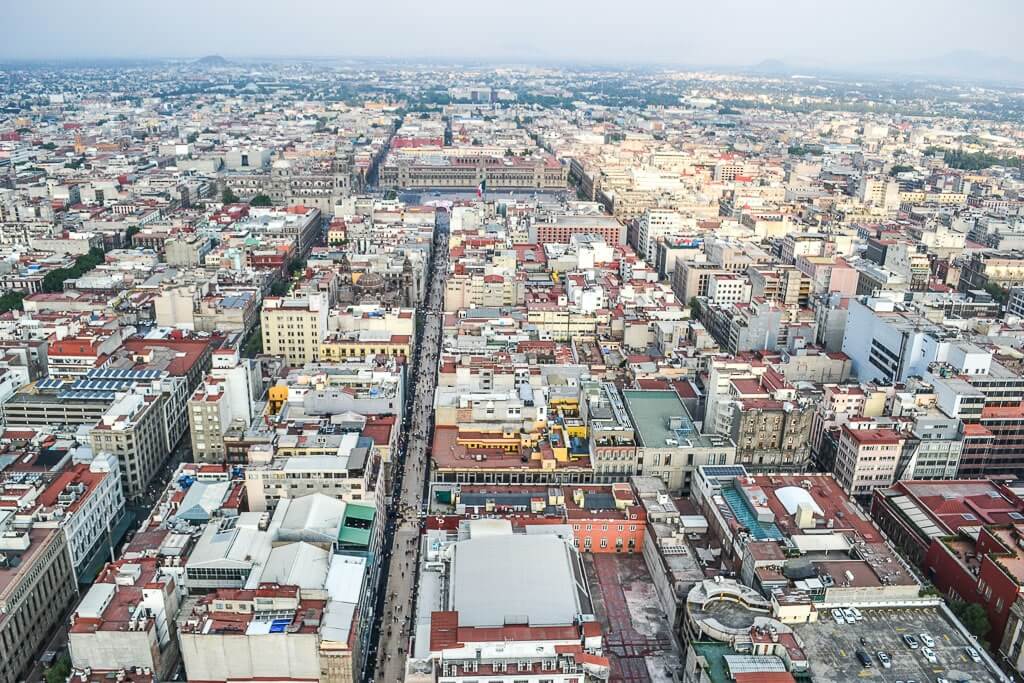
Torre Latinoamericana is easily one of the most recognizable landmarks of Mexico City.
Built in 1956, it is 44-story tall and provides sweeping views of downtown Mexico City. Just the perfect place to spend your evenings with a drink in your hand!
There is an interesting fact about Torre Latinoamericana. It is an architectural wonder because it is one of the rarest skyscrapers to ever be built in an earthquake-prone zone.
Did you know that the tower kept standing even after being hit by an 8.0 magnitude earthquake in 1985? Several structures collapsed, but not the sturdy Torre Latinoamericana.
✦ Pro Tip: Book your Torre Latinoamericana Observation Deck tickets here.
Loved this guide to famous Mexico City landmarks? Pin it for later!
